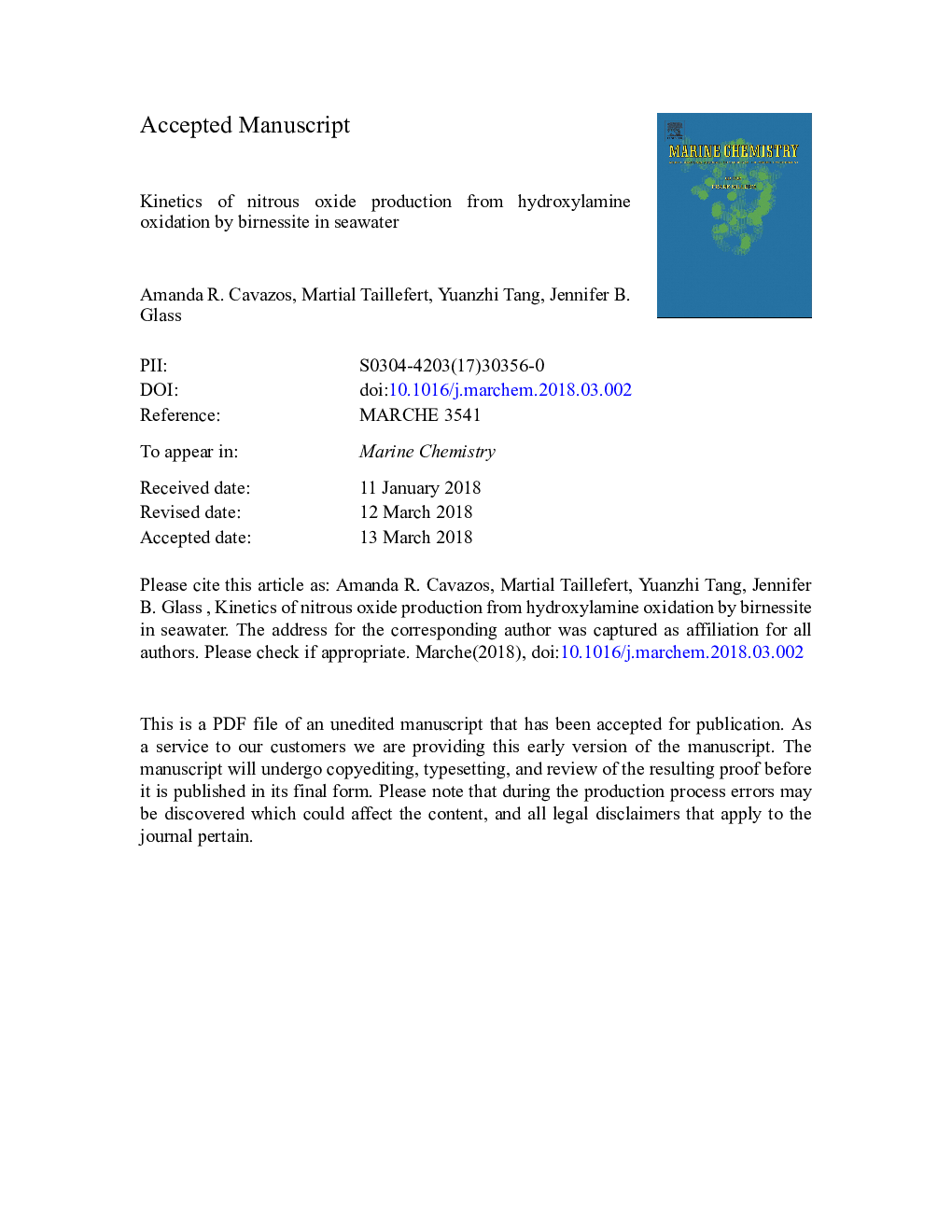| کد مقاله | کد نشریه | سال انتشار | مقاله انگلیسی | نسخه تمام متن |
|---|---|---|---|---|
| 7698810 | 1496634 | 2018 | 37 صفحه PDF | دانلود رایگان |
عنوان انگلیسی مقاله ISI
Kinetics of nitrous oxide production from hydroxylamine oxidation by birnessite in seawater
ترجمه فارسی عنوان
سینتیک تولید اکسید نیتروژن از اکسیداسیون هیدروکسیلامین بوسیله آب دریایی
دانلود مقاله + سفارش ترجمه
دانلود مقاله ISI انگلیسی
رایگان برای ایرانیان
کلمات کلیدی
اکسید نیتروژن، سینتیک، اکسید منگنز، هیدروکسیل آمین
موضوعات مرتبط
مهندسی و علوم پایه
شیمی
شیمی (عمومی)
چکیده انگلیسی
This study characterized the kinetics of abiotic production of the greenhouse gas nitrous oxide (N2O) by chemical oxidation of the nitrification intermediate hydroxylamine (NH2OH) in seawater at circumneutral pH (6.2-8.3). The oxidant was birnessite, a ubiquitous manganese oxide mineral in a variety of marine environments. Experiments using microsensor electrodes for high-resolution measurements of N2O production combined with the simultaneous measurements of the removal of NH2OH using spectrophotometric techniques revealed that the reaction was overall first order with the rate law d[N2O]/dtâ¯=â¯k[NH2OH]0.9[MnO2]0.3[H+]0 where k is 0.01â¯sâ1. Birnessite consistently oxidized 80-100% of NH2OH to N2O within 3â¯min. Mass balance on nitrogen indicated rapid formation and disappearance of an intermediate species that was evidently involved in the formation of N2O. In the presence of a nitroxyl (HNO) scavenger, N2O production rates and yield were suppressed by 17-59% and ~50%, respectively, suggesting that HNO is an intermediate in NH2OH oxidation to N2O. These results support a mechanism whereby Mn(IV) is reduced to Mn(III) with the formation of an aminoxyl radical as the first product of NH2OH oxidation, which donates a second electron to another Mn(IV) center, or reduces the same Mn(III), to release Mn2+ and HNO in solution. The final step is predicted to be HNO dimerization to N2O given the complete oxidation of NH2OH to N2O at steady-state. The experimentally-derived second-order rate constant for the dimerization step suggests that adsorption of HNO onto the excess solid surface controls the rate of N2O formation. Our findings suggest that abiotic NH2OH oxidation could be an important source of N2O in coastal ecosystems such as open oceans and oxygen minimum zones as well as sediment ecosystems wherever nitrification occurs in the presence of particulate metal oxides.
ناشر
Database: Elsevier - ScienceDirect (ساینس دایرکت)
Journal: Marine Chemistry - Volume 202, 20 May 2018, Pages 49-57
Journal: Marine Chemistry - Volume 202, 20 May 2018, Pages 49-57
نویسندگان
Amanda R. Cavazos, Martial Taillefert, Yuanzhi Tang, Jennifer B. Glass,
